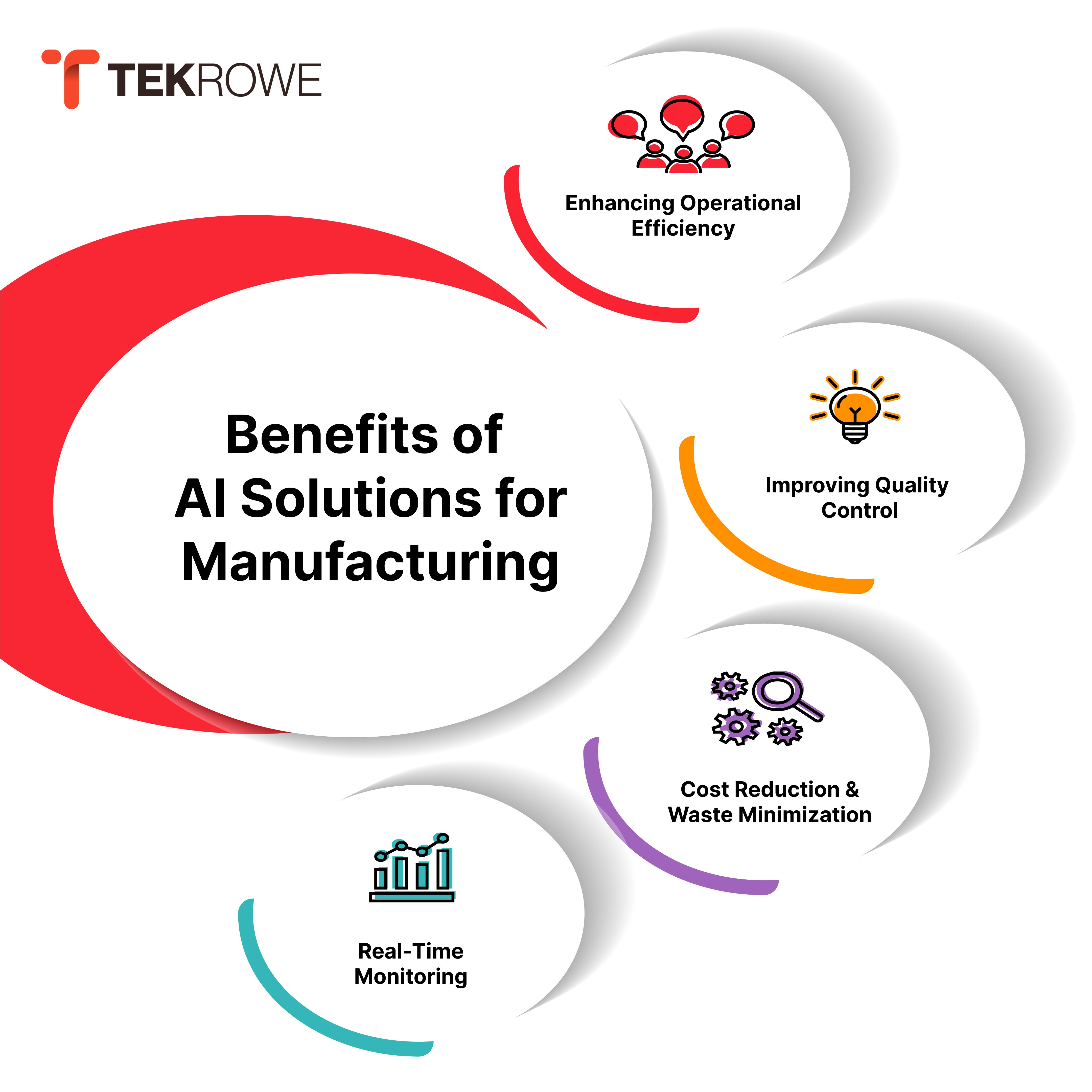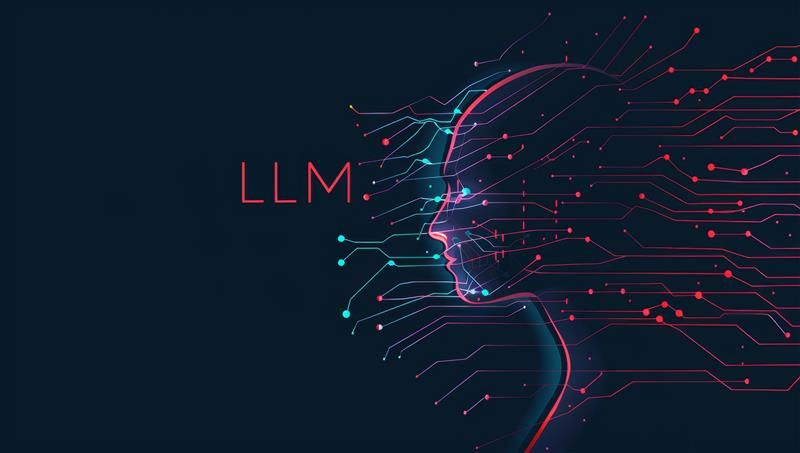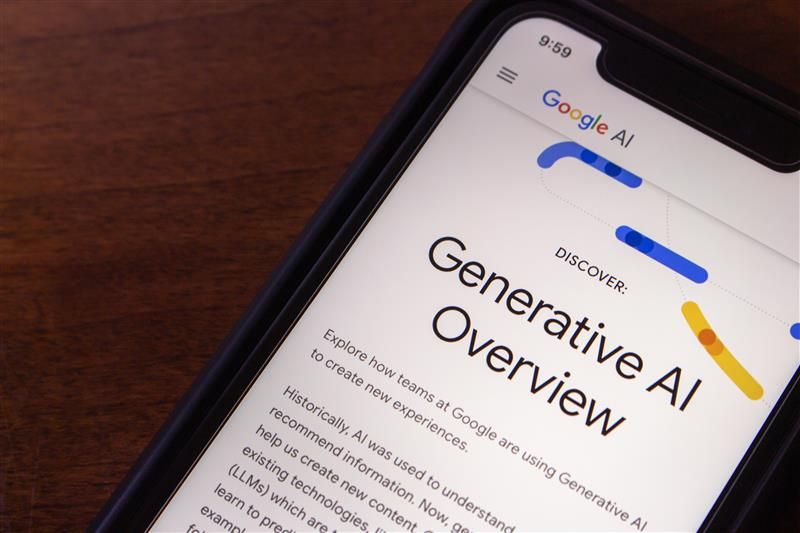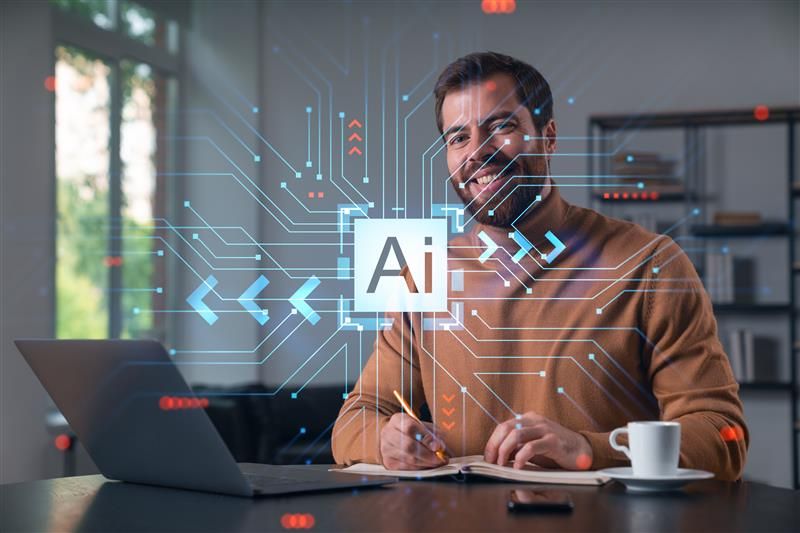In today’s ever-evolving world, technology is revolutionizing every aspect of our lives, and manufacturing is no exception. The adoption of AI solutions for manufacturing is rapidly transforming how factories operate, optimize processes, and maintain quality. According to McKinsey, AI adoption in manufacturing could boost productivity by up to 40% over the next decade. AI is becoming a game-changer for manufacturers, providing unmatched precision, efficiency, and the ability to solve complex problems autonomously.
Artificial intelligence (AI) has moved beyond just science fiction and is now making its mark in industries around the globe. In the manufacturing sector, AI is no longer a mere buzzword—it’s the key to unlocking new efficiencies, boosting quality, and staying competitive. A study by PwC suggests that AI could contribute up to $15.7 trillion to the global economy by 2030, with manufacturing being a major beneficiary. This technology empowers manufacturers to optimize production lines, ensure consistent quality, and make informed decisions using data-driven insights.
Understanding AI in Manufacturing
What is Artificial Intelligence?
Artificial intelligence refers to machines' ability to mimic human intelligence, allowing them to perform tasks like decision-making, learning, and problem-solving. In manufacturing, AI takes center stage by empowering machinery and systems to become smarter and more adaptive. Imagine a machine that can learn from past mistakes, just like humans do—sounds amazing, right?
AI is fundamentally changing how manufacturers approach problem-solving. Instead of relying solely on human intervention, machines equipped with AI can analyze situations, determine the best course of action, and even learn from their own experiences. This ability to "think" allows machines to optimize processes, improve quality, and minimize downtime.
How AI Integrates into the Manufacturing Process
AI integrates into the manufacturing process in various forms, such as predictive analytics, robotics, and even chatbots. AI systems can learn from historical production data, predict outcomes, and even take corrective actions autonomously. It turns regular factories into "smart factories" that operate more efficiently and adapt faster to changes.
One key area where AI has made significant strides is in predictive analytics. By analyzing historical production data, AI can forecast potential issues before they happen, enabling manufacturers to proactively address problems. This integration reduces downtime, minimizes waste, and ensures smoother production lines. Imagine a factory where machinery rarely breaks down because AI is always one step ahead, this is the power of AI in action.
The Evolution of Manufacturing with AI
A Brief History of AI in Manufacturing
AI in manufacturing began as simple automation—machines were given specific instructions to carry out repetitive tasks. However, with advancements in machine learning and data analysis, AI has evolved into a sophisticated tool that can adapt, learn, and optimize operations without human intervention.
The journey from traditional automation to AI-powered manufacturing has been transformative. Initially, machines were designed to perform a limited set of actions repetitively. However, as technology advanced, AI algorithms enabled machines to become more intelligent, making autonomous decisions and adapting to new situations. Today, factories are no longer just automated, they are intelligent, capable of understanding complex scenarios and responding effectively.
The Rise of Smart Manufacturing
Smart manufacturing is all about connectivity and data. AI, combined with the Internet of Things (IoT), has allowed machines to communicate, exchange data, and make intelligent decisions. This convergence has given rise to smart manufacturing, where factories are more flexible, data-driven, and productive.
Smart manufacturing isn't just about producing goods more quickly; it's about producing them more intelligently. By integrating IoT devices with AI systems, manufacturers can collect real-time data from machines and sensors, allowing for real-time analysis and decision-making. This connectivity enhances every aspect of the production process—from quality control to supply chain management—making it possible to create a truly agile manufacturing environment.
Benefits of AI Solutions for Manufacturing

Enhancing Operational Efficiency
AI helps manufacturers boost their operational efficiency by reducing machine downtime and optimizing production schedules. For example, AI-driven predictive maintenance ensures that machinery is serviced before a breakdown occurs, keeping production lines running smoothly.
Operational efficiency is at the heart of every manufacturing facility. AI’s ability to analyze data and predict potential failures helps manufacturers avoid unplanned downtimes. Imagine having a system that can detect the early signs of wear and tear in machinery, allowing technicians to intervene before the equipment fails. This capability not only reduces downtime but also extends the life of machinery, ultimately saving costs and increasing productivity.
Improving Quality Control
Quality is key in manufacturing, and AI plays a vital role in maintaining and improving it. Through AI-powered visual inspection, manufacturers can spot defects in real-time, resulting in fewer defective products and enhanced customer satisfaction.
Quality control has always been a critical aspect of manufacturing, and with AI, it’s taken to the next level. AI-powered computer vision systems can inspect products for defects far more accurately than human inspectors. These systems are not prone to fatigue and can operate continuously, ensuring that every product that leaves the production line is flawless. This level of precision not only reduces waste but also builds trust with customers by delivering consistently high-quality products.
Cost Reduction and Waste Minimization
AI solutions for manufacturing also focus on minimizing waste and reducing costs. By optimizing inventory management and improving demand forecasting, AI helps manufacturers lower waste and cut costs related to excess production or storage.
Reducing costs is a primary goal for any manufacturer, and AI plays a pivotal role in achieving this. By predicting demand more accurately, AI helps manufacturers produce only what is needed, minimizing the risk of overproduction and the associated waste. Moreover, AI can optimize energy usage, ensuring that machinery operates only when necessary, leading to significant cost savings in the long run.
How is AI used in the manufacturing industry?
Real-Time Monitoring
AI is used for real-time monitoring of production lines. By collecting and analyzing data continuously, AI can detect anomalies and alert operators before a problem escalates, thereby maintaining production flow.
Real-time monitoring is critical for maintaining high production standards. AI systems can analyze data from multiple sensors simultaneously, providing insights into the health of machinery and identifying potential issues before they become serious. This proactive approach ensures that production runs smoothly, reducing the risk of costly downtimes and ensuring consistent product quality.
Production Planning and Scheduling
AI helps optimize production planning by taking into account various factors such as demand forecasts, available resources, and production capacity. This optimization leads to improved efficiency and lower production costs.
Effective production planning is essential for meeting customer demand while minimizing costs. AI systems can analyze historical sales data, market trends, and resource availability to create optimal production schedules. By doing so, manufacturers can ensure that they are always ready to meet demand without overproducing or incurring unnecessary expenses.
Inventory Management
Managing inventory can be challenging, but AI helps by predicting demand, optimizing stock levels, and ensuring that the right materials are available when needed. This reduces the risk of overstocking or stockouts.
AI-driven inventory management systems can predict future demand with remarkable accuracy. By analyzing sales trends, seasonal variations, and other factors, AI can help manufacturers maintain the right inventory levels, reducing carrying costs and ensuring that materials are available when needed. This kind of dynamic inventory management helps in minimizing waste and improving overall efficiency.
AI Applications in Manufacturing
Predictive Maintenance
One of the most valuable applications of AI in manufacturing is predictive maintenance. By analyzing data collected from sensors in machinery, AI can predict when a machine is likely to fail, allowing manufacturers to perform maintenance before it becomes a costly issue.
Predictive maintenance is revolutionizing how manufacturers maintain their equipment. Instead of adhering to a fixed maintenance schedule, AI allows for a more dynamic approach—servicing machinery only when necessary. This approach not only reduces maintenance costs but also ensures that machinery is always in optimal working condition, ultimately boosting overall productivity.
Robotics and Automation
AI-driven robotics are a game-changer for manufacturing. Unlike traditional robots that follow fixed instructions, AI-powered robots are adaptive and can handle complex tasks with precision. This adaptability allows for greater flexibility in production lines.
AI-powered robots can work alongside human workers, making manufacturing environments more collaborative. These robots can take over repetitive and physically demanding tasks, allowing human workers to focus on more complex, value-added activities. This collaboration between humans and robots is helping manufacturers achieve a perfect balance between automation and human creativity.
Quality Inspection
AI-based computer vision systems are used to inspect products at various stages of the manufacturing process. These systems can detect even the smallest defects that human inspectors might miss, ensuring consistent product quality.
Quality inspection is a time-consuming yet critical task. AI systems equipped with computer vision can inspect products at speeds far beyond human capability, ensuring that each product meets the desired quality standards. This not only reduces the chance of defects reaching the customer but also helps manufacturers maintain their reputation for quality and reliability.
Supply Chain Optimization
AI helps optimize the entire supply chain by analyzing data from suppliers, production lines, and customers. This optimization results in more efficient supply chain management, lower costs, and improved customer satisfaction.
A well-optimized supply chain is crucial for manufacturing success. AI can predict potential disruptions in the supply chain and suggest alternate suppliers or routes, ensuring that production continues without interruption. By optimizing inventory levels and streamlining logistics, AI helps manufacturers reduce costs and improve overall supply chain resilience.
AI's Impactful Innovations: Transforming Manufacturing with Real-World Success
AI in Automotive Manufacturing
The automotive industry is at the forefront of AI adoption. Companies like BMW and Tesla use AI for predictive maintenance, defect detection, and even in designing the cars themselves. AI enables manufacturers to streamline production and ensure the highest quality standards.
AI is also being used in autonomous vehicle development, which requires advanced AI algorithms to process data from sensors, cameras, and other systems. In production facilities, AI-driven robots handle complex assembly tasks, ensuring precision and reducing human error. The combination of AI in both production and product development is pushing the automotive industry into a new era of innovation.
AI in Electronics and Semiconductor Manufacturing
Electronics and semiconductor manufacturing require extreme precision. AI solutions are used to control processes with high accuracy, ensuring the right conditions for optimal production. Companies like Intel use AI to improve yield rates and reduce waste.
AI is essential in semiconductor manufacturing, where even the smallest defects can lead to significant losses. By using AI to monitor production conditions and adjust parameters in real-time, manufacturers can ensure that each batch meets strict quality requirements. This precision is crucial in an industry where product performance depends on microscopic details.
AI in Food and Beverage Manufacturing
AI is also making waves in the food and beverage industry. By using AI for quality control, food manufacturers can ensure that their products meet stringent safety and quality standards, reducing the risk of recalls and customer dissatisfaction.
In addition to quality control, AI helps food manufacturers optimize production schedules based on demand forecasts. This helps in reducing waste, ensuring that the right amount of product is made at the right time. AI is also used to monitor equipment, ensuring that food is processed under ideal conditions, which is vital for maintaining quality and safety.
AI Technologies Used in Manufacturing
Machine Learning
Machine learning is at the core of AI solutions for manufacturing. By analyzing large amounts of data, machine learning algorithms can identify patterns, optimize processes, and even predict future outcomes, which is invaluable for efficient production.
Machine learning models can analyze historical data to identify inefficiencies and suggest improvements. For instance, in a production line, machine learning can determine the ideal settings for different machines to maximize output and minimize waste. This kind of optimization is impossible to achieve through traditional methods, making machine learning a game-changing technology in manufacturing.
Computer Vision
Computer vision enables machines to “see” and analyze visual information. In manufacturing, it is used for quality inspection, allowing for the detection of defects and ensuring products meet the required standards.
Computer vision is particularly useful in high-speed production environments, where manual inspection is impractical. By using high-resolution cameras and sophisticated image analysis algorithms, AI systems can detect defects in real-time, ensuring that every product that leaves the production line is flawless. This capability not only ensures high quality but also boosts productivity by reducing the need for manual rework.
Natural Language Processing (NLP)
NLP is used in manufacturing to enable better human-machine interaction. Through voice commands or chatbots, workers can interact with machines in a more intuitive way, reducing the need for specialized training.
With the help of NLP, workers can operate machines using simple voice commands, making the interaction seamless and reducing training time. Chatbots powered by NLP can also assist workers by providing real-time support and answering questions about machine operation, helping to improve efficiency and reduce downtime.
The Role of Data in AI Solutions for Manufacturing
Data Collection and Analysis
Data is the backbone of AI in manufacturing. Sensors, cameras, and other data collection tools provide valuable information that AI uses to make informed decisions. Accurate data collection and analysis are critical for optimizing processes.
Manufacturers must invest in data collection systems to ensure that AI can function effectively. The more accurate the data, the more reliable the AI-driven insights will be. By collecting data from various stages of the production process, manufacturers can gain a deeper understanding of their operations, identify inefficiencies, and make informed decisions that lead to continuous improvement.
Leveraging Big Data for Smarter Operations
Manufacturers can leverage big data analytics to gain insights into their operations. By analyzing trends and patterns, they can make smarter decisions that improve productivity and efficiency.
Big data analytics allows manufacturers to identify patterns that may not be immediately apparent. For instance, by analyzing machine performance data over time, manufacturers can identify subtle trends that indicate an impending failure, allowing for preventive maintenance. By leveraging big data, manufacturers can create smarter, more efficient operations that are capable of adapting to changing demands.
Need Help with Your Business
Contact Us NowChallenges of Implementing AI in Manufacturing
Initial Investment Costs
Implementing AI solutions can be costly initially, as it requires investment in infrastructure, software, and skilled personnel. However, the long-term benefits often outweigh these costs, making it a worthwhile investment.
The cost of implementing AI can be a barrier for many manufacturers, particularly small and medium-sized enterprises. However, it’s important to consider the long-term benefits, such as reduced operational costs, improved efficiency, and higher quality. Many companies find that the return on investment (ROI) justifies the initial expenses, as AI helps them stay competitive in an increasingly challenging market.
Skills and Training Requirements
The introduction of AI also requires a workforce that is skilled in handling new technologies. Training employees to work with AI-powered systems can be a challenge for many manufacturers.
AI systems are only as effective as the people who use them. Manufacturers must invest in training programs to ensure that their workforce is capable of working alongside AI. This may involve training on how to use new software, interpret AI-generated insights, or work with AI-driven machinery. By providing adequate training, manufacturers can ensure a smooth transition to AI-powered production.
Data Privacy and Security Concerns
With the increased use of data, privacy and security become major concerns. Manufacturers need to ensure that data is stored and processed securely to protect sensitive information.
Data privacy is a significant concern, especially as more and more information is collected from machines, employees, and customers. Manufacturers must implement robust cybersecurity measures to protect this data from unauthorized access. Ensuring data privacy is not only a legal requirement but also crucial for maintaining customer trust and preventing costly data breaches.
Overcoming the Challenges of AI Adoption
Government and Policy Support
Governments can play a significant role in encouraging AI adoption in manufacturing by offering subsidies, grants, and creating policies that support technological advancements.
Government support can make AI adoption more accessible for manufacturers, especially smaller companies. Policies that provide tax incentives, grants, or subsidies can help offset the initial costs of AI implementation. Additionally, government-backed training programs can help bridge the skills gap, ensuring that the workforce is ready to take advantage of new AI technologies.
Industry Collaboration and Training Programs
Industry collaboration and training programs are also essential to overcome the skills gap. By partnering with educational institutions, manufacturers can train their workforce for the AI-driven future.
Collaboration between manufacturers, industry groups, and educational institutions can help ensure that workers have the skills needed to thrive in an AI-driven environment. By developing specialized training programs, manufacturers can prepare their workforce for the changes that AI will bring. These partnerships are essential for ensuring that the manufacturing industry as a whole can benefit from AI.
Future Trends in AI and Manufacturing
The Role of IoT in AI Integration
The Internet of Things (IoT) is helping manufacturers gather data from various sources, which AI then uses to optimize processes. The combination of IoT and AI will continue to shape the future of manufacturing.
IoT devices collect data from machinery, production lines, and even products themselves. This data is then fed into AI systems, which analyze it to optimize production processes, predict maintenance needs, and improve quality. The integration of IoT and AI creates a highly connected manufacturing environment, where data flows seamlessly, and insights are generated in real-time.
Digital Twins and Virtual Simulations
Digital twins allow manufacturers to create a virtual replica of their production lines. By simulating changes using AI, manufacturers can predict outcomes and make informed decisions without disrupting the actual production.
Digital twins are becoming an increasingly popular tool for manufacturers. By creating a virtual replica of a production line or even an entire factory, manufacturers can test different scenarios and predict the impact of changes before implementing them in the real world. This capability is invaluable for making informed decisions, reducing risks, and optimizing production.
Edge Computing in Manufacturing
Edge computing is enabling manufacturers to process data closer to the source rather than relying on cloud computing. This reduces latency and allows for real-time decision-making on the factory floor.
Edge computing is particularly important in manufacturing environments where real-time decision-making is critical. By processing data locally, manufacturers can reduce the time it takes to analyze data and make decisions. This capability is crucial for applications like predictive maintenance, where immediate action is needed to prevent equipment failure.
Case Studies of AI in Manufacturing
AI-Driven Quality Control at Tesla
Tesla employs AI-driven visual inspection systems to ensure that every car leaving the production line meets its high-quality standards. This proactive approach has enabled Tesla to uphold its reputation for quality and innovation.
Beyond quality control, Tesla utilizes AI for production planning, supply chain management, and the development of autonomous vehicles. By integrating AI into every aspect of its operations, Tesla has built a highly efficient, flexible manufacturing system that adapts to changes in demand while maintaining the highest quality standards.
Predictive Maintenance at General Electric
General Electric uses AI to monitor its machinery and predict maintenance needs before a breakdown occurs, significantly reducing downtime and maintenance costs.
Predictive maintenance has enabled General Electric to maintain high productivity levels while keeping maintenance expenses low. By analyzing sensor data from its equipment, GE can predict potential failures and carry out maintenance proactively. This approach not only minimizes downtime but also extends the lifespan of equipment, resulting in substantial cost savings.
Impact on Workforce and Jobs
Redefining Roles in Manufacturing
AI is transforming roles in the manufacturing industry. While some traditional jobs may become obsolete, new opportunities are emerging, including roles such as data analysts, AI specialists, and robot technicians.
The nature of work in manufacturing is evolving due to AI. Although automation may replace certain jobs, it also creates opportunities in fields like data analysis, AI programming, and robotics. Workers who are willing to upskill and adapt to these new roles will discover that AI provides exciting career opportunities.
Upskilling the Workforce
To keep up with the changes brought by AI, it is essential for the workforce to upskill. Many companies are investing in training programs to help their employees learn new skills and remain relevant in an AI-driven environment.
Manufacturers are recognizing the importance of investing in their workforce. By providing training programs focused on AI, machine learning, and data analysis, companies can ensure that their employees are prepared for the changes that AI will bring. Upskilling the workforce not only benefits the employees but also helps companies remain competitive in an increasingly technology-driven industry.
Ethical Considerations of AI in Manufacturing
Ethical Manufacturing Practices
AI must be used ethically in manufacturing to prevent unfair labor practices or negative societal impacts. Responsible AI use is essential for sustainable development.
Ethical considerations are becoming increasingly important as AI becomes more prevalent in manufacturing. Manufacturers must ensure that AI benefits both the company and society, avoiding practices that lead to job displacement without retraining opportunities, and ensuring transparency and responsibility in AI systems.
Transparency and Accountability in AI Systems
AI systems should be transparent, and manufacturers must be accountable for the decisions made by AI. This transparency helps build trust in AI systems among workers and consumers alike.
Transparency in AI systems is crucial for building trust. Manufacturers must ensure that the decisions made by AI systems can be understood and explained. This is particularly important when AI is used in quality control or decision-making processes that directly impact employees or customers. By ensuring transparency and accountability, manufacturers can build trust and acceptance of AI technologies.
AI and Sustainable Manufacturing
Reducing Energy Consumption
AI helps manufacturers reduce energy consumption by optimizing processes and minimizing machine idle time, thereby contributing to sustainability efforts and lowering production costs.
As sustainability becomes a priority for manufacturers, AI plays a key role in achieving these goals. By analyzing energy usage patterns, AI identifies areas of waste and suggests improvements. For example, AI can optimize machine operation schedules to reduce energy consumption during peak hours, benefiting both the environment and production costs.
Optimizing Resource Utilization
AI ensures that resources are used efficiently, reducing waste and minimizing the environmental impact of manufacturing activities. Sustainable practices are becoming a core focus for AI in the industry.
Resource optimization is another area where AI is making a significant impact. By predicting demand accurately and optimizing production schedules, AI helps manufacturers use raw materials more efficiently, reducing waste. This not only minimizes the environmental impact but also helps manufacturers save costs, making sustainable practices economically viable.
AI-Enabled Smart Factories
Features of a Smart Factory
A smart factory uses AI, IoT, and automation to create an interconnected, data-driven environment. These factories are flexible, efficient, and capable of rapid adaptation to changes in demand.
Smart factories represent the future of manufacturing. By integrating AI and IoT, these factories can respond to changes in demand in real-time, optimize production processes, and maintain high-quality standards. The ability to adapt quickly to market changes gives smart factories a significant competitive advantage in the fast-paced manufacturing landscape.
Examples of AI-Driven Smart Factories
Companies like Siemens and Bosch have embraced AI-driven smart factories, where AI optimizes production schedules, reduces downtime, and improves overall efficiency.
Siemens and Bosch are leading the way in implementing smart factory technologies. By using AI to analyze production data and optimize processes, these companies have created highly efficient manufacturing environments that can adapt quickly to changing demands. The use of AI in these smart factories is setting new standards for efficiency, quality, and adaptability in the manufacturing industry.
The Competitive Advantage of AI in Manufacturing
Staying Ahead in the Global Market
AI gives manufacturers a competitive edge by enabling faster production, better quality, and lower costs. Staying ahead of the competition in a global market requires embracing AI and its transformative power.
In a global market where competition is fierce, manufacturers need every advantage they can get. AI provides that edge by allowing manufacturers to produce high-quality products more efficiently and at a lower cost. By embracing AI, manufacturers can stay ahead of their competitors and maintain a strong position in the global market.
AI as a Differentiator for Businesses
AI allows manufacturers to differentiate themselves by offering customized products, reducing lead times, and maintaining consistent quality—all of which are key differentiators in a competitive industry.
Customization is becoming increasingly important to consumers, and AI allows manufacturers to meet this demand. By analyzing customer preferences and production capabilities, AI can help manufacturers offer personalized products without compromising efficiency. This ability to offer customized products while maintaining high quality and low costs sets manufacturers apart in an increasingly competitive industry.
Practical Steps for Implementing AI in Manufacturing
Assessing Current Processes
Before implementing AI, manufacturers need to assess their current processes and identify areas where AI can provide the most significant benefit. Understanding the existing bottlenecks and inefficiencies is crucial.
Assessing current processes is the first step in implementing AI effectively. Manufacturers need to understand where their operations are falling short and how AI can help address these issues. This assessment involves analyzing production data, identifying bottlenecks, and determining where AI can have the most significant impact, whether it’s in quality control, maintenance, or supply chain optimization.
Creating a Roadmap for AI Adoption
A clear roadmap is essential for successful AI adoption. This roadmap should include goals, timelines, and resources needed to implement AI solutions, ensuring a smooth transition.
A well-defined roadmap is crucial for successful AI implementation. This roadmap should outline the goals of AI adoption, the steps needed to achieve these goals, and the resources required. By having a clear plan in place, manufacturers can ensure that AI implementation is systematic, efficient, and aligned with their overall business objectives.
Conclusion
The impact of AI solutions for manufacturing is profound, from optimizing operations to ensuring quality and sustainability. While there are challenges in adopting AI, the benefits far outweigh the hurdles. As manufacturers continue to embrace AI, the industry will become more efficient, innovative, and competitive. Now is the time to adopt AI solutions and be part of the transformation that is reshaping the manufacturing industry.
AI is not just a trend—it’s a revolution that is transforming the manufacturing landscape. By leveraging AI, manufacturers can optimize every aspect of their operations, from production planning to quality control, ensuring they stay ahead in an increasingly competitive market. The time to act is now—those who embrace AI today will lead the industry tomorrow.
FAQs
- What are the benefits of using AI in manufacturing? AI helps improve efficiency, quality, and reduce costs by optimizing production processes and minimizing waste.
- How is AI different from traditional automation in manufacturing? Unlike traditional automation, which follows set instructions, AI can learn and adapt, making it more flexible and capable of handling complex tasks.
- What are some examples of AI applications in manufacturing? AI is used for predictive maintenance, quality inspection, robotics, and supply chain optimization in manufacturing.
- Is AI implementation in manufacturing expensive? While initial costs can be high, the long-term benefits of AI—such as reduced downtime and improved efficiency—often justify the investment.
- How does AI impact jobs in the manufacturing industry? AI redefines roles, leading to the creation of new job opportunities while making some traditional jobs obsolete. Upskilling is essential to adapt to these changes.




